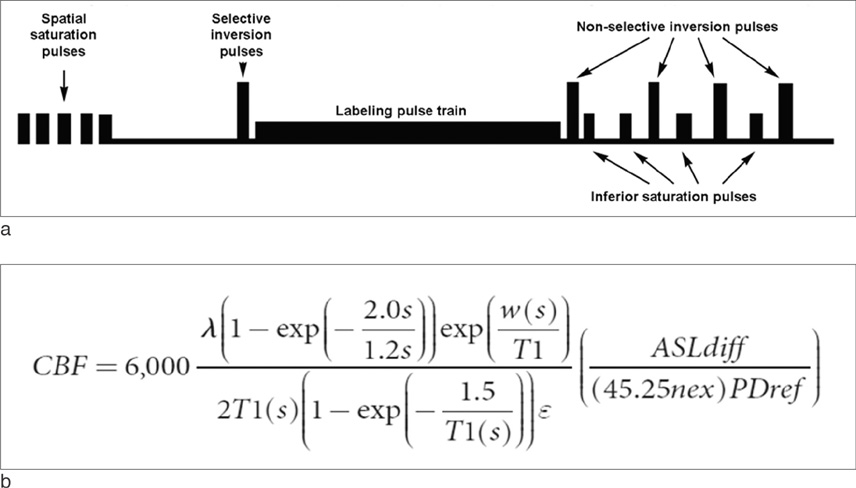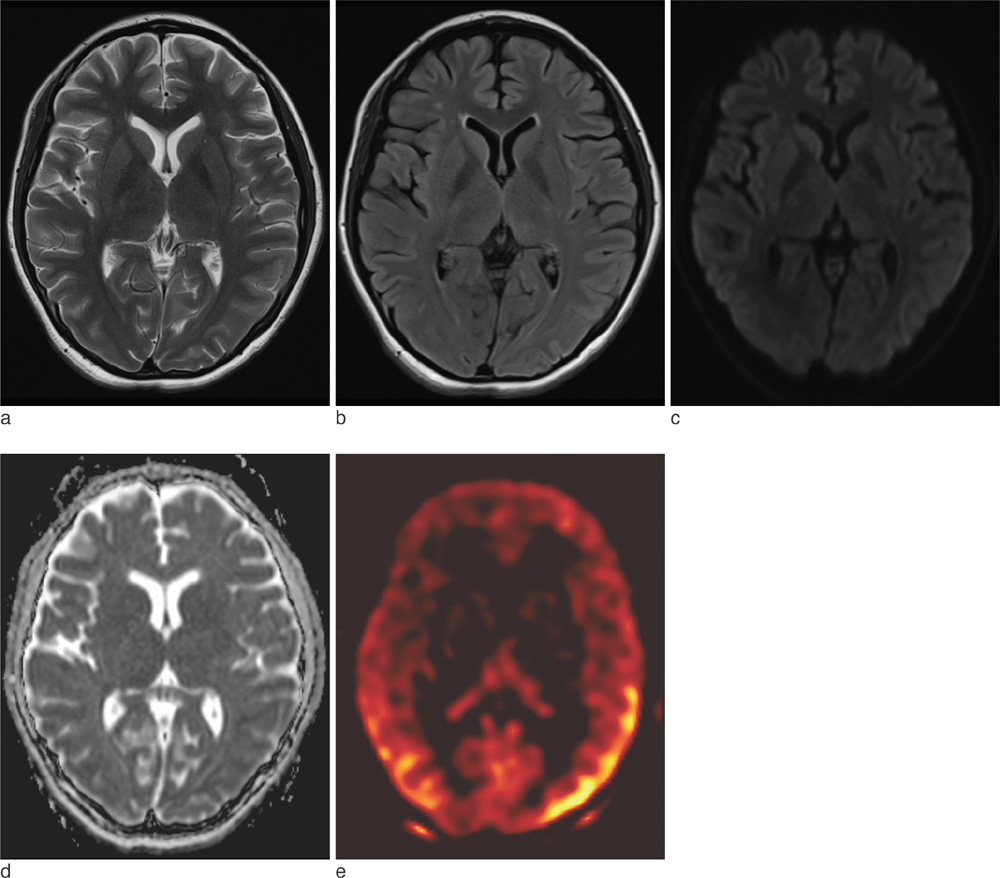J Korean Soc Magn Reson Med.
2012 Aug;16(2):142-151. 10.13104/jksmrm.2012.16.2.142.
Pseudo Continuous Arterial Spin Labeling MR Imaging of Status Epilepticus
- Affiliations
-
- 1Departement of Radiology, Seoul National University College of Medicine, Seoul, Korea. verocay@snuh.org
- 2Department of Neurology, Seoul National University Hospital, Seoul, Korea.
- KMID: 2099848
- DOI: http://doi.org/10.13104/jksmrm.2012.16.2.142
Abstract
- PURPOSE
The purpose of this study was to describe arterial spin labeling MR image findings of status epilepticus.
MATERIALS AND METHODS
A retrospective chart review within our institute revealed six patients who had been clinically diagnosed as status epilepticus and had also undergone MR imaging that included ASL in addition to routine sequences.
RESULTS
Six patients with status epilepticus were studied by conventional MR and arterial spin labeling imaging. All patients showed increased regional CBF correlating with EEG pathology. Notably, in two patients, conventional MRI and DWI showed no abnormal findings whereas pCASL demonstrated regional increased CBF in both patients.
CONCLUSION
Arterial spin labeling might offer additional diagnostic capabilities in the evaluation of patients with status epilepticus.
Keyword
Figure
Reference
-
1. Jack C, Sharbrough F, Twomey C, et al. Temporal lobe seizures: lateralization with MR volume measurements of the hippocampal formation. Radiology. 1990. 175:423–429.2. Jackson G, Berkovic S, Duncan J, Connelly A. Optimizing the diagnosis of hippocampal sclerosis using MR imaging. AJNR Am J Neuroradiol. 1993. 14:753–762.3. Lansberg M, O'Brien M, Norbash A, Moseley M, Morrell M, Albers G. MRI abnormalities associated with partial status epilepticus. Neurology. 1999. 52:1021–1027.4. Men S. Selective neuronal necrosis associated with status epilepticus: MR findings. AJNR Am J Neuroradiol. 2000. 21:1837–1840.5. Treiman DM, Meyers PD, Walton NY, et al. Veterans affairs status epilepticus cooperative study group. A comparison of four treatments for generalized convulsive status epilepticus. N Engl J Med. 1998. 339:792–798.6. Shepherd SM. Management of status epilepticus. Emerg Med Clin North Am. 1994. 12:941–961.7. Meierkord H, Holtkamp M. Non-convulsive status epilepticus in adults: clinical forms and treatment. Lancet Neurol. 2007. 6:329–339.8. Devinsky O, Kelley K, Porter RJ, Theodore WH. Clinical and electroencephalographic features of simple partial seizures. Neurology. 1988. 38:1347–1352.9. Williamson PD, Spencer DD, Spencer SS, Novelly RA, Mattson RH. Complex partial seizures of frontal lobe origin. Ann Neurol. 1985. 18:497–504.10. Duncan R. Epilepsy, cerebral blood flow, and cerebral metabolic rate. Cerebrovasc Brain Metab Rev. 1992. 4:105–121.11. Schwartz TH. Neurovascular coupling and epilepsy: hemodynamic markers for localizing and predicting seizure onset. Epilepsy Curr. 2007. 7:91–94.12. Engelhorn T, Hufnagel A, Weise J, Baehr M, Doerfler A. Monitoring of acute generalized status epilepticus using multilocal diffusion MR imaging: early prediction of regional neuronal damage. AJNR Am J Neuroradiol. 2007. 28:321–327.13. Hauf M, Slotboom J, Nirkko A, Von Bredow F, Ozdoba C, Wiest R. Cortical regional hyperperfusion in nonconvulsive status epilepticus measured by dynamic brain perfusion CT. AJNR Am J Neuroradiol. 2009. 30:693–698.14. Szabo K, Poepel A, Pohlmann-Eden B, et al. Diffusion-weighted and perfusion MRI demonstrates parenchymal changes in complex partial status epilepticus. Brain. 2005. 128:1369–1376.15. Bauer J, Stefan H, Huk W, et al. CT, MRI and SPECT neuroimaging in status epilepticus with simple partial and complex partial seizures: case report. J Neurol. 1989. 236:296–299.16. Katz A, Bose A, Lind SJ, Spencer SS. SPECT in patients with epilepsia partialis continua. Neurology. 1990. 40:1848–1850.17. Tatum WO, Alavi A, Stecker MM. Technetium-99m-HMPAO SPECT in partial status epilepticus. J Nucl Med. 1994. 35:1087–1094.18. Detre JA, Leigh JS, Williams DS, Koretsky AP. Perfusion imaging. Magn Reson Med. 1992. 23:37–45.19. Dixon WT, Du LN, Faul DD, Gado M, Rossnick S. Projection angiograms of blood labeled by adiabatic fast passage. Magn Reson Med. 1986. 3:454–462.20. Yang Y, Frank JA, Hou L, Ye FQ, McLaughlin AC, Duyn JH. Multislice imaging of quantitative cerebral perfusion with pulsed arterial spin labeling. Magn Reson Med. 1998. 39:825–832.21. Pollock JM, Tan H, Kraft RA, Whitlow CT, Burdette JH, Maldjian JA. Arterial spin-labeled MR perfusion imaging: clinical applications. Magn Reson Imaging Clin N Am. 2009. 17:315–338.22. Toledo M, Munuera J, Salas-Puig X, Santamarina E, Lacuey N, Rovira A. Localisation value of ictal arterial spin-labelled sequences in partial seizures. Epileptic Disord. 2011. 13:336–339.23. Pollock JM, Deibler AR, West TG, Burdette JH, Kraft RA, Maldjian JA. Arterial spin-labeled magnetic resonance imaging in hyperperfused seizure focus: a case report. J Comput Assist Tomogr. 2008. 32:291–292.24. Dai W, Garcia D, De Bazelaire C, Alsop DC. Continuous flow-driven inversion for arterial spin labeling using pulsed radio frequency and gradient fields. Magn Reson Med. 2008. 60:1488–1497.25. Garcia D, De Bazelaire C, Alsop D. Pseudo-continuous flow driven adiabatic inversion for arterial spin labeling. Proceedings of thirteenth scientific meeting and exhibition of the international society for magnetic resonance in medicine. 2005. May 7-13, 2005; Miami, Fla: ISMRM;37.26. Kaplan PW. The clinical features, diagnosis, and prognosis of nonconvulsive status epilepticus. Neurologist. 2005. 11:348–361.27. Shneker BF, Fountain NB. Assessment of acute morbidity and mortality in nonconvulsive status epilepticus. Neurology. 2003. 61:1066–1073.28. Cole AJ. Status epilepticus and periictal imaging. Epilepsia. 2004. 45:72–77.29. Duffner F, Freudenstein D, Schiffbauer H, et al. Combining MEG and MRI with neuronavigation for treatment of an epileptiform spike focus in the precentral region: a technical case report. Surg Neurol. 2003. 59:40–45.30. Sadowski EA, Bennett LK, Chan MR, et al. Nephrogenic systemic fibrosis: risk factors and incidence estimation. Radiology. 2007. 243:148–157.31. Wintermark M, Sesay M, Barbier E, et al. Comparative overview of brain perfusion imaging techniques. Stroke. 2005. 36:e83–e99.32. Kang M, Choi JC, Kwon HJ, et al. Cerebral Perfusion MR findings before and after a carotid stent. J Korean Soc Radiol. 2009. 61:79–85.33. Zaharchuk G, Bammer R, Straka M, et al. Arterial spin-label imaging in patients with normal bolus perfusion-weighted MR imaging findings: pilot identification of the borderzone sign. Radiology. 2009. 252:797–807.34. Kim JA, Chung JI, Yoon PH, et al. Transient MR signal changes in patients with generalized tonicoclonic seizure or status epilepticus: periictal diffusion-weighted imaging. AJNR Am J Neuroradiol. 2001. 22:1149–1160.35. Borgstrom L, Chapman A, Siesjo B. Glucose consumption in the cerebral cortex of rat during bicuculline induced status epilepticus. J Neurochem. 1976. 27:971–973.36. Meldrum BS, Nilsson B. Cerebral blood flow and metabolic rate early and late in prolonged epileptic seizures induced in rats by bicuculline. Brain. 1976. 99:523–542.37. Schomer DL. Focal status epilepticus and epilepsia partialis continua in adults and children. Epilepsia. 1993. 34:S29–S36.38. Chapman A, Meldrum B, Siesio B. Cerebral metabolic changes during prolonged epileptic seizures in rats. J Neurochem. 1977. 28:1025–1035.39. Engelhorn T, Doerfler A, Weise J, Baehr M, Forsting M, Hufnagel A. Cerebral perfusion alterations during the acute phase of experimental generalized status epilepticus: prediction of survival by using perfusion-weighted MR imaging and histopathology. AJNR Am J Neuroradiol. 2005. 26:1563–1570.40. O'Brien TJ. SPECT: methodology. Adv Neurol. 2000. 83:11–32.41. Warach S, Levin J, Schomer D, Holman B, Edelman R. Hyperperfusion of ictal seizure focus demonstrated by MR perfusion imaging. AJNR Am J Neuroradiol. 1994. 15:965–968.42. Tatlidil R. Persistent postictal hyperperfusion demonstrated with PET. Epilepsy Res. 2000. 42:83–88.43. Takeshita G, Toyama H, Nakane K, et al. Evaluation of regional cerebral blood flow changes on perifocal brain tissue SPECT before and after removal of arteriovenous malformations. Nucl Med Commun. 1994. 15:461–468.44. Stanisz GJ, Odrobina EE, Pun J, et al. T1, T2 relaxation and magnetization transfer in tissue at 3T. Magn Reson Med. 2005. 54:507–512.
- Full Text Links
- Actions
-
Cited
- CITED
-
- Close
- Share
- Similar articles
-
- Arterial Spin Labeling Perfusion MRI of Crossed Cerebellar Diaschisis in a Patient with Simple Partial Status Epilepticus
- Arterial Spin Labeling Magnetic Resonance Imaging in Healthy Adults: Mathematical Model Fitting to Assess Age-Related Perfusion Pattern
- Ictal Images of Simple Partial Status Epilepticus
- Arterial Spin Labelling Perfusion, Proton MR Spectroscopy and Susceptibility-Weighted MR Findings of Acute Necrotizing Encephalopathy: a Case Report
- The Imaging of Localization Related Symptomatic Epilepsies: The Value of Arterial Spin Labelling Based Magnetic Resonance Perfusion





